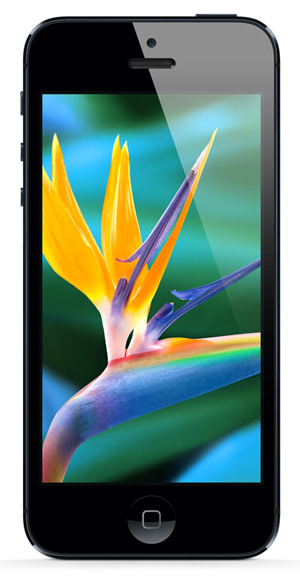An analysis of Apple's new iPhone 5 display


On Tuesday I analyzed Apple's iPhone 5 display based on leaked specifications. Now that it's official I asked Raymond Soneira, President of DisplayMate Technologies to give me his exclusive thoughts on the specifications behind the panel shipping in Apple's new flagship smartphone, the iPhone 5.
First, the specs:
- 1136 * 640 pixels
- 4-inches
- Retina
- 326 PPI
- sRGB 44% more color saturation
- Most accurate display in the industry
Soneira had this to say:
As analyzed in my Display News article on the iPhone 5 Display Predictions, that is pretty much what was predicted and expected. I was hoping for a True HD 1280x720 display for the reasons I indicated there.
When the Retina Display was introduced with the iPhone 4 in 2010 it was a major advancement that blew every existing Smartphone display away. The iPhone 5 display still looks like it will be a great display, but it has slipped behind the leading edge for Smartphone displays.
For example, the upcoming Nokia Lumia 920 has a 1280x768 IPS LCD display and the upcoming Huawei Ascend U9500 has a 1280x720 IPS LCD display. The Samsung Galaxy S III and Google Galaxy Nexus also have 1280x720 displays (but they are PenTile displays that aren't as sharp as standard RGB displays).
My upcoming Smartphone Display Shoot-Out (in about 10 days) will be an in-depth analysis and comparison of the displays on iPhone 5 and the Samsung Galaxy S III - similar in scope to my new iPad Display Shoot-Out. When the Nokia Lumia 920 and Huawei Ascend U9500 launch later this fall I will expand the Smartphone Display Shoot-Out to include them. We'll see exactly how well each of these displays actually performs.
sRGB 44% more color saturation
Apple's Marketing SVP Phil Schiller made two subtle but very important announcements regarding the iPhone 5 display, which I doubt were fully appreciated by anyone in the audience (and may have been intended for me):
1. The iPhone 5 will have "44% more color saturation." This is exactly what was stated during the new iPad announcement in March with regard to the iPad 2. They are not technically correct statements in this context, but the new iPad has a virtually perfect Standard Color Gamut, and from Schiller's comment it seems that the iPhone 5 will have a similar virtually perfect Standard Color Gamut as well. This figure (below) shows the Color Gamuts for the devices.
2. The iPhone 5 is the "Most accurate display in the industry." This remark echoes the conclusion from my new iPad Display Shoot-Out article: "the new iPad’s picture quality, color accuracy, and gray scale are not only much better than any other Tablet or Smartphone, it’s also much better than most HDTVs, laptops, and monitors. In fact with some minor calibration tweaks the new iPad would qualify as a studio reference monitor." It's clear that Apple intends the iPhone 5 to have state-of-the-art picture quality and color accuracy.
Why is the above really important? Because it points to why there will be an actual Apple Television in the near future. The following is from my Sherlock Holmes Predictions for the iPhone 5 and Apple Television:
Deduction Number 1: The iPhone 5 will have photometry and colorimetry that is identical to the new iPad 3 in the same way that the iPhone 4 and iPad 2 are identical. Again, this is not an accident, but will be the basis of a major strategic decision by Apple. Starting with the new iPad 3, images on all future Apple devices and displays will appear visually identical and with extremely accurate colors and images.
Why this is Important: The devices from every other manufacturer are not only inaccurate and different but also inconsistent from device to device and model to model. So all images look different on every Smartphone, Tablet, and HDTV. This is especially bad when people have multiple devices and are sharing personal photos with family and friends because everyone wants to be sure that they look just as good to everyone else as they do on their own devices. Right now that is definitely not the case... See my Mobile Shoot-Outs and HDTV Shoot-Outs for proof.
Why Apple will Introduce an Actual Television: Why does Apple need to introduce its own Apple Television with an actual TV screen as opposed to just relying on an Apple TV streaming box connected to some other brand of TV? Because all existing TVs produce inaccurate and inconsistent colors and images that will be poor matches to Apple's own iPhones and iPads. Photo sharing is especially important and convenient on WiFi and internet connected TVs.